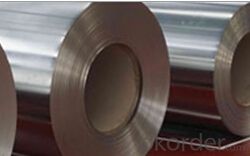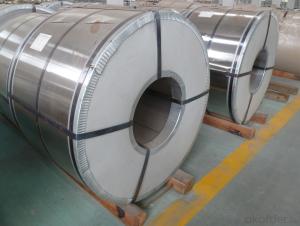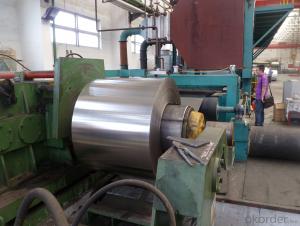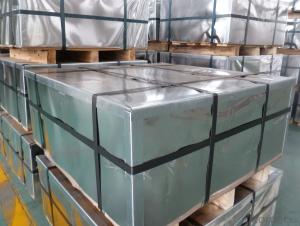PET Laminiated TFS for 0.19mm Thickness Sheets
- Loading Port:
- Shanghai
- Payment Terms:
- TT OR LC
- Min Order Qty:
- 10 m.t.
- Supply Capability:
- 1000 m.t./month
OKorder Service Pledge
OKorder Financial Service
You Might Also Like
Item specifice
PET Laminiated TFS for 0.19mm Thickness Sheets
1.Structure of Description
PET Laminiated TFS for 0.19mm Thickness Sheets is one of the metal packing materials, which is widely used for making painting cans ,chemical package cans , electrical cable ,battery and metal printing etc.We are one of the professional producer for PET laminitad TFS. At present, ourproductivity is about 100000 MT/year.
2. Main Features
Steady and high quality
Fast shipment
Good experience for export work
For the surface, Plate uniform in thickness,uniform and smooth tin coating, without flaws,rusts,scratch,wave,nick of tin coating etc.
Price competitive
3. Images

4. Specification
TEMPER: T1-T5, DR7-9
ANNEALING:BA/ CA
THICKNESS: 0.15~0.45mm
WIDTH: 600~1050mm
Packaging Detail: For coils: Anti-rust paper +metal cover +corner protected +woodskid Laded into 20 feet container with max weight 25 tons;For sheets: Thinplastic film +rust-proof paper +metal cover +metal angles + straps + pallet.Loaded in 20 feet container with weight 25 tons.
5.FAQ
The main product tinplate and tin freesteel are metal package material widely used in food, light industry andchemical industry. We organize our production strictly in accordance with Q/ZYBE1、Q/ZYB E3、GB/T252, GB/T24180, JIS G3303, JIS G3315 and ISO11950 or equivalentstandards. Companies adhere to principles of quality, food safety, environment,occupation, health safety and energy, say "excellent quality to win thetrust of customers, health and safety to gain the trust of the public, clean environmentto harvest the trust of the community, safety and health to convince employeesand energy-saving to be trusted by public". We are enjoying the trust andgood name regarding to the superior quality and prefer service among thecustomers. Our products are sold nearly 150 enterprises including Europe,America, Oceania, Middle East and Southeast Asia.
Company management system is healthy, operational mechanism runninggood. After years of effort, base on the introduction, absorption, digestion ofthe advanced technology, techniques, equipment, we gradually set up the uniqueproduction process and technical support system which is market need-orientaland suite to the Chinese condition. In the fierce market competition, ourcompany will continue to pursue the excellence quality and outstanding service,and provide more and better service and service to meet customers demand onmetal package home and abroad.
- Q:How does tinplate packaging contribute to product tamper resistance?
- Tinplate packaging contributes to product tamper resistance by providing a strong and durable barrier that is difficult to manipulate or breach without leaving visible signs of tampering. Its sturdy construction and sealed nature make it harder for unauthorized individuals to access the product, ensuring its integrity and safety.
- Q:How is tinplate used in the manufacturing of electronic devices?
- Tinplate is commonly used in the manufacturing of electronic devices as it provides an ideal material for the production of casing and outer components. Its corrosion-resistant properties help protect the internal circuitry from environmental factors, ensuring durability and longevity of the electronic device. Additionally, tinplate's malleability allows for easy shaping and customization, enabling manufacturers to create sleek and aesthetically pleasing designs.
- Q:What are the different coating options for tinplate?
- Some different coating options for tinplate include tin-free steel (TFS), electrolytic tinplate (ETP), tin-free steel with lacquer, and organic coatings such as epoxy or polyester. These coatings provide various levels of corrosion resistance and can be chosen based on the specific requirements of the application.
- Q:How does tinplate packaging contribute to product convenience?
- Tinplate packaging contributes to product convenience by providing a durable and lightweight solution that is easy to handle and store. The tin coating on the packaging helps preserve the product's freshness and protect it from external elements, extending its shelf life. Additionally, tinplate packaging is easy to open and reseal, allowing for effortless access to the product and ensuring its convenience for consumers.
- Q:What is tin plate?
- Tinplate is a tin covered with tin, it is not easy to rust, also known as tin iron. Tinplate was most premature in Bohemia (now Czech and Slovakia). The land has been rich in metal since ancient times, advanced in technology, and know how to use water power in the manufacture of machinery, from fourteenth Century onwards began to produce tinplate. For a long time, it has been the main source of tinplate in the world. Tin was mainly used for making tableware and drinking utensils.
- Q:What are the environmental impacts of using tinplate?
- The environmental impacts of using tinplate include deforestation due to the extraction of tin ore, air and water pollution from mining and smelting processes, and the release of greenhouse gases during production. Additionally, the disposal of tinplate products can contribute to landfill waste.
- Q:How does tinplate packaging contribute to food safety?
- Tinplate packaging contributes to food safety by providing a protective barrier that prevents contamination from external factors such as light, air, and moisture. This helps to preserve the quality, freshness, and nutritional value of the packaged food. Additionally, tinplate packaging is highly resistant to corrosion, ensuring that harmful substances do not leach into the food. Its durability also prevents physical damage during transportation and storage, reducing the risk of contamination.
- Q:Can tinplate be used for high-temperature applications?
- No, tinplate is not suitable for high-temperature applications as it has a low melting point.
- Q:What are the main challenges in tinplate manufacturing?
- Some of the main challenges in tinplate manufacturing include ensuring consistent quality of the tin coating, maintaining precise thickness and uniformity of the tinplate, managing the handling and storage of the tinplate to prevent damage or contamination, and addressing environmental concerns related to the tin coating process and waste disposal. Additionally, the industry faces the challenge of meeting customer demands for cost-effective production while adhering to strict regulatory standards and keeping up with technological advancements.
- Q:How does tinplate perform in terms of UV resistance?
- Tinplate has limited UV resistance and is not inherently UV stable. However, it can be coated or painted with UV-resistant materials to enhance its resistance to UV radiation.
1. Manufacturer Overview |
|
|---|---|
| Location | |
| Year Established | |
| Annual Output Value | |
| Main Markets | |
| Company Certifications | |
2. Manufacturer Certificates |
|
|---|---|
| a) Certification Name | |
| Range | |
| Reference | |
| Validity Period | |
3. Manufacturer Capability |
|
|---|---|
| a)Trade Capacity | |
| Nearest Port | |
| Export Percentage | |
| No.of Employees in Trade Department | |
| Language Spoken: | |
| b)Factory Information | |
| Factory Size: | |
| No. of Production Lines | |
| Contract Manufacturing | |
| Product Price Range | |
Send your message to us
PET Laminiated TFS for 0.19mm Thickness Sheets
- Loading Port:
- Shanghai
- Payment Terms:
- TT OR LC
- Min Order Qty:
- 10 m.t.
- Supply Capability:
- 1000 m.t./month
OKorder Service Pledge
OKorder Financial Service
Similar products
New products
Hot products
Related keywords




























